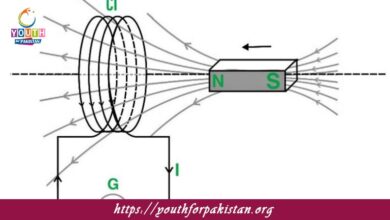Determination Of The Rate Of A Chemical Reaction MDCAT MCQs

Welcome to the Determination Of The Rate Of A Chemical Reaction MDCAT MCQs with Answers. In this post, we have shared Determination Of The Rate Of A Chemical Reaction Multiple Choice Questions and Answers for PMC MDCAT 2024. Each question in MDCAT Chemistry offers a chance to enhance your knowledge regarding Determination Of The Rate Of A Chemical Reaction MCQs in this MDCAT Online Test.
The rate of a chemical reaction can be determined by measuring:
a) The concentration of products only
b) The temperature of the reaction mixture
c) The concentration of reactants over time
d) The volume of the reaction vessel
The initial rate of a reaction is determined by:
a) Measuring the rate after the reaction has reached equilibrium
b) Measuring the concentration of reactants at equilibrium
c) Measuring the change in concentration of reactants at the start of the reaction
d) Measuring the rate of formation of products at equilibrium
In the method of initial rates, the rate of reaction is determined by:
a) Monitoring the reaction at various temperatures
b) Measuring the rate when the concentration of reactants is varied
c) Observing the rate after the reaction has reached completion
d) Determining the equilibrium constant of the reaction
The rate of a reaction can be measured by:
a) The change in volume of the gas evolved
b) The color change of the reactants
c) The pressure change during the reaction
d) All of the above
The half-life of a reaction is:
a) The time required for half of the reactant to be consumed
b) The time required for the reaction to reach equilibrium
c) The time required for the reaction rate to double
d) The time at which the reaction stops
The method of integrating the rate law involves:
a) Plotting the rate versus concentration of reactants
b) Plotting the concentration of reactants versus time
c) Plotting the rate constant versus temperature
d) Plotting the equilibrium constant versus concentration
To determine the rate law of a reaction, you must:
a) Measure the rate of reaction at different temperatures
b) Measure the concentration of reactants at equilibrium
c) Vary the concentration of reactants and measure the rate
d) Calculate the activation energy of the reaction
In the method of initial rates, the rate of reaction is measured:
a) After the reaction has been allowed to reach completion
b) As the reaction mixture is continuously stirred
c) At the beginning of the reaction before significant changes in concentration occur
d) After the equilibrium state has been achieved
The order of a reaction can be determined by:
a) Measuring the reaction rate at different temperatures
b) Varying the concentration of one reactant while keeping others constant and observing the effect on rate
c) Measuring the total pressure at equilibrium
d) Analyzing the color change of the reaction mixture
The rate of a reaction can be calculated using:
a) The change in absorbance of the solution over time
b) The change in temperature of the reaction mixture
c) The volume of gas produced per unit time
d) The concentration of products at equilibrium
The method of half-life can be used to determine:
a) The order of the reaction
b) The rate constant of the reaction
c) Both the order of the reaction and the rate constant
d) The equilibrium constant of the reaction
To determine the reaction order from experimental data, you should:
a) Measure the time required for the reaction to reach completion
b) Use the integrated rate laws for different orders and compare which gives the best fit
c) Measure the change in pressure during the reaction
d) Observe the color change of the products
The rate of reaction can be affected by:
a) Temperature
b) Concentration of reactants
c) Presence of a catalyst
d) All of the above
To determine the rate constant
k using the method of initial rates, you:
a) Measure the rate at different temperatures
b) Vary the concentration of reactants and measure the initial rates
c) Measure the concentration of products at equilibrium
d) Calculate the activation energy of the reaction
The rate law for a reaction is determined by:
a) The stoichiometry of the reaction
b) The concentration of reactants at equilibrium
c) Experimental data showing the relationship between rate and concentration
d) The equilibrium constant of the reaction
In a zero-order reaction, the rate of reaction is:
a) Directly proportional to the concentration of reactants
b) Inversely proportional to the concentration of reactants
c) Independent of the concentration of reactants
d) Proportional to the temperature
The rate of a reaction can be measured by:
a) Monitoring the change in color of the reaction mixture
b) Measuring the temperature change of the reaction
c) Observing the volume change in the reaction vessel
d) All of the above
For a first-order reaction, the half-life is:
a) Dependent on the initial concentration of reactants
b) Independent of the initial concentration of reactants
c) Proportional to the temperature
d) Inversely proportional to the rate constant
The rate constant
k for a reaction can be determined by:
a) Measuring the reaction rate at different concentrations and plotting the data
b) Determining the equilibrium constant of the reaction
c) Measuring the change in volume of gas over time
d) Observing the color change of the reaction mixture
In the method of continuous variations, the rate of reaction is monitored by:
a) Varying the temperature of the reaction mixture
b) Measuring the concentration of one reactant while varying the concentration of the other
c) Measuring the volume of gas evolved
d) Determining the change in pH of the reaction mixture
The method of half-life is useful for determining:
a) The temperature dependence of the reaction rate
b) The rate law and the order of the reaction
c) The equilibrium position of the reaction
d) The concentration of reactants at equilibrium
To determine the reaction order, one can use:
a) The method of initial rates
b) The method of continuous variations
c) The method of half-life
d) All of the above
The rate of reaction is independent of the concentration of reactants in:
a) A first-order reaction
b) A second-order reaction
c) A zero-order reaction
d) A third-order reaction
The effect of concentration on the rate of a reaction is best studied by:
a) Varying the temperature
b) Changing the pressure
c) Measuring the reaction rate at different concentrations of reactants
d) Observing the color change of the reaction mixture
The method of measuring reaction rate by gas volume involves:
a) Measuring the amount of gas produced at different times
b) Measuring the change in concentration of the liquid reactants
c) Monitoring the color change of the reaction mixture
d) Measuring the temperature change of the reaction mixture
In the method of measuring reaction rate by colorimetry, the rate is determined by:
a) Measuring the change in color of the reactants or products
b) Measuring the temperature of the reaction mixture
c) Observing the volume of gas produced
d) Measuring the change in pressure of the reaction mixture
The rate of reaction can be determined from the concentration of reactants or products using:
a) The method of continuous variation
b) The method of initial rates
c) The method of integrated rate laws
d) The method of equilibrium constant
The rate constant
k is dependent on:
a) The concentration of reactants
b) The temperature of the reaction
c) The pressure of the reaction mixture
d) The volume of the reaction vessel
The half-life of a zero-order reaction:
a) Decreases as the concentration of reactants decreases
b) Increases as the concentration of reactants decreases
c) Is independent of the initial concentration of reactants
d) Is directly proportional to the rate constant
The rate of a reaction can be increased by:
a) Increasing the concentration of reactants
b) Increasing the temperature
c) Adding a catalyst
d) All of the above
The rate of reaction for a given concentration of reactants is generally:
a) Higher at a lower temperature
b) Lower at a higher temperature
c) Higher at a higher temperature
d) Unaffected by temperature changes
The rate constant
k for a reaction is:
a) A measure of the reaction rate at equilibrium
b) Constant for all temperatures and concentrations
c) Specific to a given reaction and changes with temperature
d) Equal to the equilibrium constant of the reaction
To determine the order of a reaction experimentally, one can use:
a) The method of integrated rate laws
b) The method of initial rates
c) The method of equilibrium constants
d) Both a and b
The rate of reaction for a reaction at equilibrium is:
a) Constant and dependent on reactant concentration only
b) Zero as the reaction has stopped
c) Variable and depends on both forward and reverse reaction rates
d) Not measurable as the reaction rate is at equilibrium
If you are interested to enhance your knowledge regarding Physics, Chemistry, Computer, and Biology please click on the link of each category, you will be redirected to dedicated website for each category.





